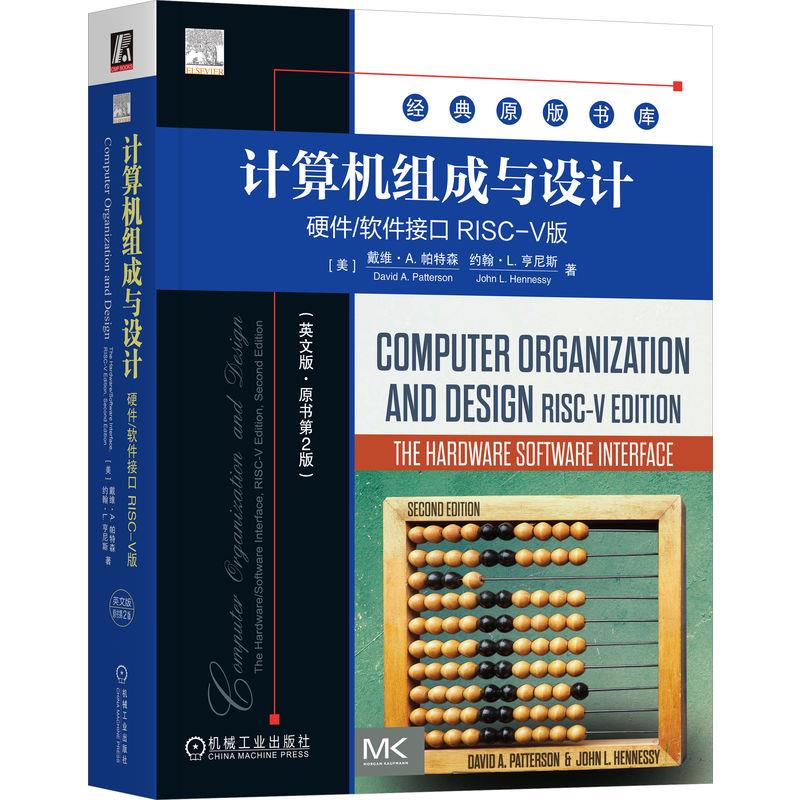
计算机组成与设计:硬件/软件接口 RISC-V版(英文版·原书第2版)

- ISBN:9787111742661
- 装帧:一般胶版纸
- 册数:暂无
- 重量:暂无
- 开本:16开
- 页数:712
- 出版时间:2024-01-01
- 条形码:9787111742661 ; 978-7-111-74266-1
本书特色
图灵奖得主联袂撰写,计算机体系结构新黄金时代必读之作 本书由图灵奖得主Patterson和Hennessy联袂撰写,是计算机体系结构新黄金时代必读之作。根据读者的需求,这一版将RV64切换为RV32,减少10条指令,降低学习难度;新增关于领域定制体系结构(DSA)的讨论,使用Google的TPUv1作为示例,还新增了TPUv3 DSA超级计算机与NVIDIA Volta GPU集群的比较;每一章都增加了“性能提升”一节,分别采用数据级并行、指令级并行、线程级并行等方法,仅增加21行代码便使矩阵乘法程序加速近50 000倍,直观呈现出硬件对提高能效的重要性。
内容简介
本书由2017年图灵奖得主Patterson和Hennessy共同撰写,是计算机体系结构领域的经典书籍,强调软硬件协同设计及其对性能的影响。本书采用开源的RISC-V指令系统体系结构,讲解硬件技术、指令、算术运算、流水线、存储层次、I/O以及并行处理器等。第2版将RV64切换为RV32以降低学习难度,新增关于领域定制体系结构(DSA)的讨论以反映新的技术趋势。此外,每一章都增加了“性能提升”和“自学”章节,并更新了大量练习题。本书适合计算机体系结构领域的专业技术人员参考,也适合高等院校计算机相关专业的学生阅读。<br />
目录
作者简介
戴维·A. 帕特森(David A. Patterson),自1977年加入加州大学伯克利分校以来,他一直在该校教授计算机体系结构课程,并在那里担任计算机科学Pardee教席。他曾因教学工作获得加州大学杰出教学奖、ACM Karlstrom奖、IEEE Mulligan教育奖章以及IEEE本科教学奖。因为对RISC的贡献,Patterson获得了IEEE技术进步奖和ACM Eckert-Mauchly奖,并因为对RAID的贡献分享了IEEE Johnson信息存储奖。他和Hennessy共同获得了IEEE John von Neumann奖章以及C&C奖金。与Hennessy一样,Patterson是美国国家工程院、美国国家科学院、美国艺术与科学院和计算机历史博物馆院士,ACM和IEEE会士,并入选了硅谷工程名人堂。他曾担任加州大学伯克利分校电气工程与计算机科学(EECS)系计算机科学分部主任、计算研究学会主席和ACM主席。这些工作使他获得了ACM、CRA以及SIGARCH的杰出服务奖。他因在科学普及和计算多样化方面的贡献而获得了Tapia成就奖,并与Hennessy共同获得了2017年ACM图灵奖。在伯克利,Patterson领导了RISC I的设计与实现工作,这可能是**台VLSI精简指令系统计算机,为商用SPARC体系结构奠定了基础。他也是廉价磁盘冗余阵列(RAID)项目的领导者,RAID技术引导许多公司开发出了高可靠的存储系统。他还参加了工作站网络(NOW)项目,正是因为该项目,才有了被互联网公司广泛使用的集群技术以及后来的云计算。这些项目获得了四个ACM*佳论文奖。2016年,他成为伯克利的荣休教授和谷歌杰出工程师,在谷歌,他致力于面向机器学习的领域定制体系结构的研究工作。他还是RISC-V国际协会副主席和RISC-V国际开源实验室主任。 约翰·L.亨尼斯(John L. Hennessy),斯坦福大学第十任校长,从1977年开始任教于该校电气工程与计算机科学系。Hennessy是IEEE和ACM会士,美国国家工程院、美国国家科学院、美国哲学院以及美国艺术与科学院院士。Hennessy获得的众多奖项包括:2001年ACM Eckert-Mauchly奖(因对RISC的贡献),2001年Seymour Cray计算机工程奖,2000年与Patterson共同获得IEEE John von Neumann奖章,2017年又与Patterson共同获得ACM图灵奖。他还获得了七个荣誉博士学位。1981年,Hennessy带领几位研究生在斯坦福大学开始研究MIPS项目。1984年完成该项目后,他暂时离开大学,与他人共同创建了MIPS Computer Systems公司(现在的MIPS Technologies公司),该公司开发了早期的商用 RISC 微处理器之一。2006年,已有超过20亿个MIPS微处理器应用在从视频游戏和掌上计算机到激光打印机和网络交换机的各类设备中。Hennessy后来领导了共享存储器体系结构(DASH)项目,该项目设计了**个可扩展cache一致性多处理器原型,其中的很多关键思想都在现代多处理器中得到了应用。除了参与科研活动和履行学校职责之外,Hennessy还作为前期顾问和投资者参与了很多初创项目,为相关领域学术成果的商业化做出了杰出贡献。他目前是Knight-Hennessy学者奖学金项目的主管,并担任Alphabet的非执行董事长。
-

MySQL数据库案例教程
¥34.9¥49.8 -

硅谷之火-人与计算机的未来
¥12.7¥39.8 -

删繁就简-单片机入门到精通
¥27.3¥39.0 -

计算
¥92.2¥128.0 -

秒懂剪映应用技巧
¥43.7¥59.8 -

抖音短视频
¥18.1¥42.0 -

C语言程序设计
¥31.9¥45.5 -

C程序设计(第五版)
¥34.3¥49.0 -

C语言程序设计(第4版)
¥41.3¥59.0 -

人工智能
¥17.6¥55.0 -

UNIX环境高级编程(第3版)
¥174.0¥229.0 -

中文版PHOTOSHOP 2024完全自学教程
¥83.9¥119.8 -

智能控制与强化学习先进值迭代评判设计
¥104.9¥139.8 -

实战数据可视化Excel篇
¥27.4¥49.8 -

人工智能应用基础(第2版)
¥32.7¥46.0 -

做好课题申报:AI辅助申请书写作
¥48.9¥69.8 -

企业AI之旅
¥43.5¥79.0 -

高效写论文:AI辅助学术论文写作
¥48.9¥69.8 -

可编程控制器系统应用编程(中级)
¥41.9¥59.8 -

因果漫步
¥65.0¥89.0










